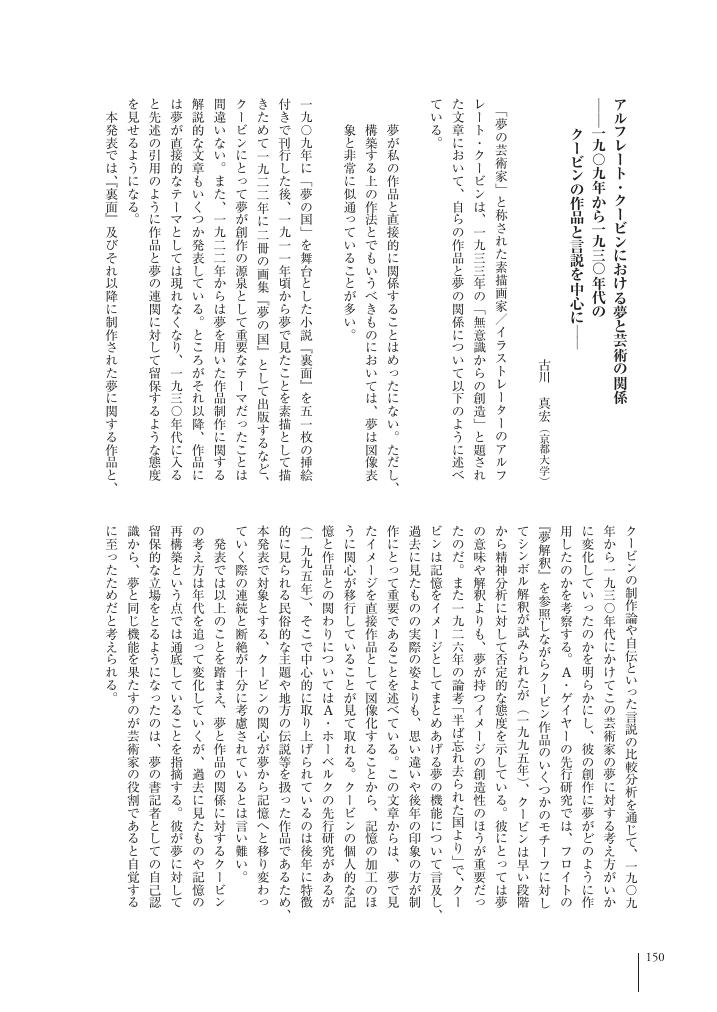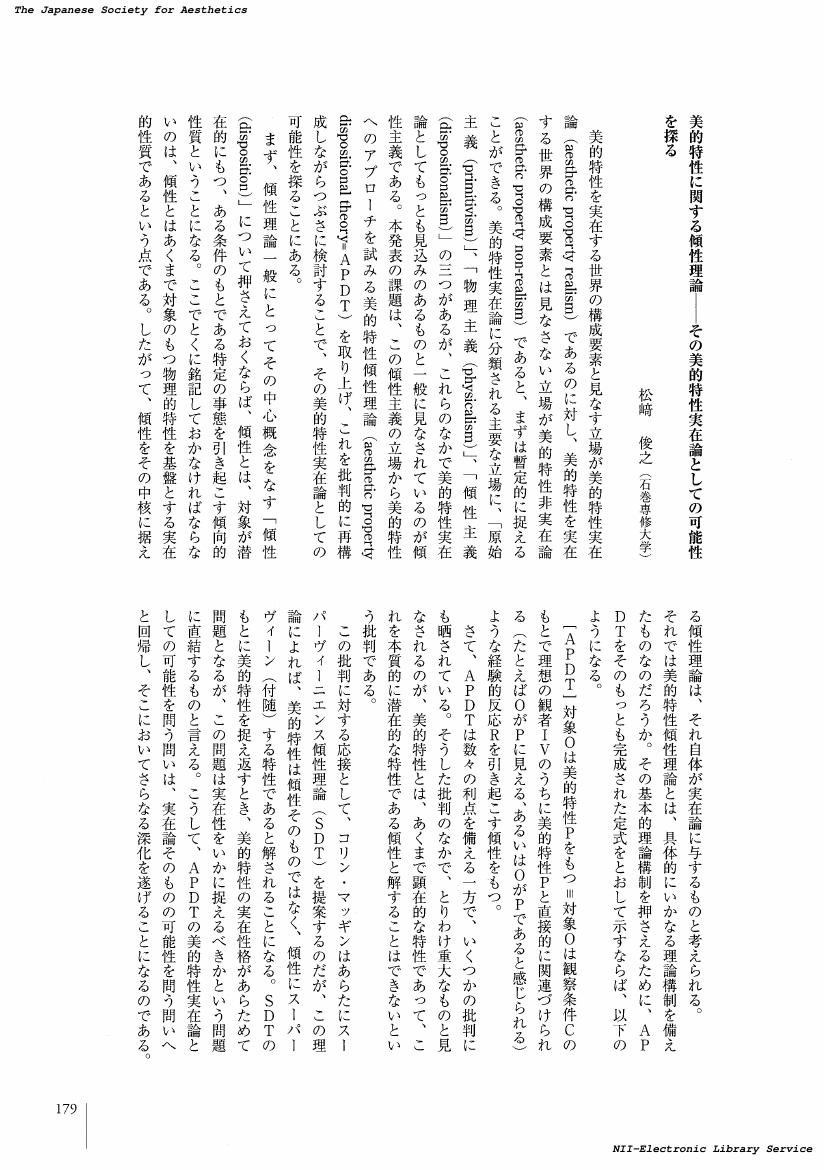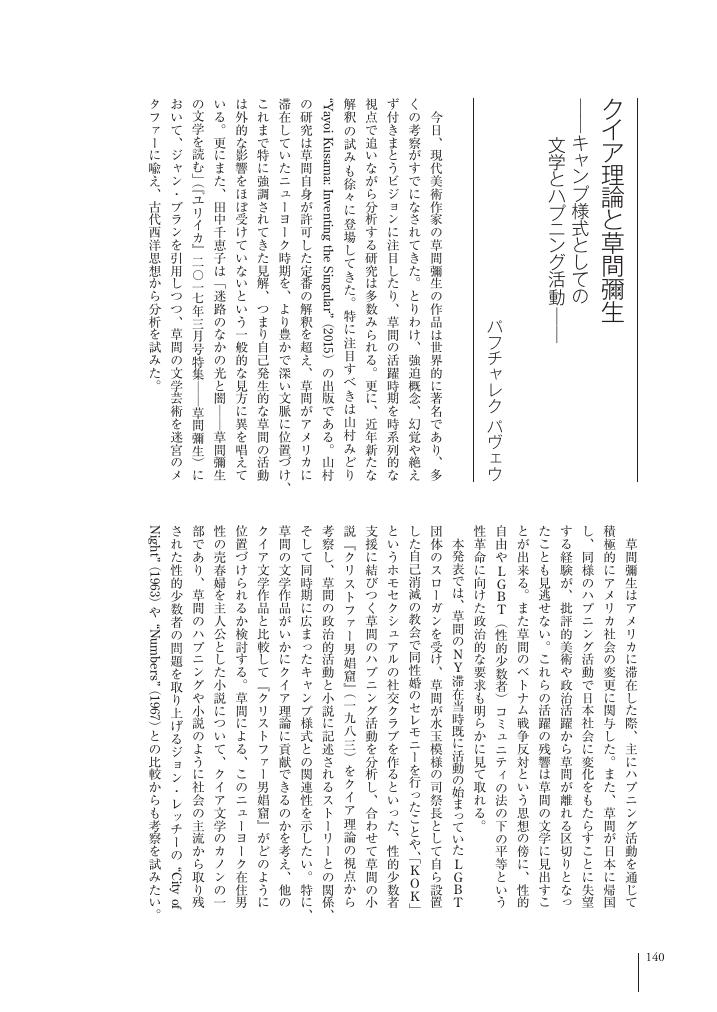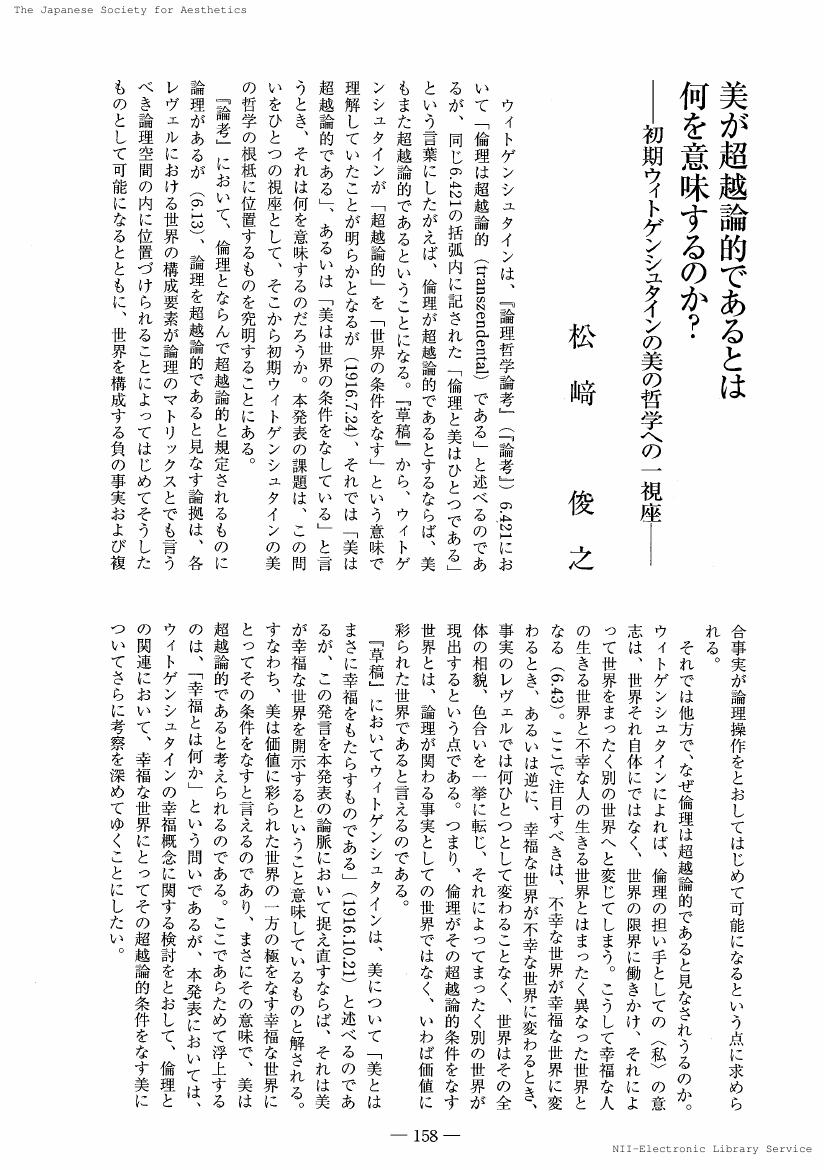2 0 0 0 OA 日常生活の感性論としての貨幣の感性論 : ガブリエルとジンメル
- 著者
- 杉山 卓史
- 出版者
- 美学会
- 雑誌
- 美学 (ISSN:05200962)
- 巻号頁・発行日
- vol.61, no.2, pp.1-12, 2010-12-31 (Released:2017-05-22)
"Alltagsasthetik" ist eines der neuen Gebiete der Asthetik. Das ist ein Ergebnis des seit dem Ende des letzten Jahrhunderts versuchten Verstandnisses der Asthetik als der Theorie der sinnlichen Erkenntnis, welches ihre Gegenstande nicht auf die Kunst und das Schone beschrankt, und sucht das Asthetische aus alltaglichen Dingen zu sehen. Ist das aber bloss Erweiterung der Gegenstande oder Anwendung der Methode der traditionellen Asthetik auf alltagliche Dinge? Auf diese Frage mochte ich in diesem Aufsatz am Beispiel der Asthetik und Rhetorik des Geldes (2002) von Gottfried Gabriel, einer Pionierstudie der "Asthetik des Geldes", antworten. Gabriel versucht aufzuzeigen, wie sich die quantitative Grosse Geld der asthetischen Qualitaten bedient hat. Diese Fragestellung ist deshalb von Bedeutung fur die "Alltagsasthetik", weil sie das Dogma der modernen Asthetik dekonstruieren will, dem zufolge das Asthetische nicht in Materie sondern in Form bestehe. Andererseits behauptet er aber durch den Vergleich der Pfennig-Munzen der BRD und DDR, dass die Kontinuitat der Munzbilder die Abwertung der Munzmaterien ausgleicht. Das ist eine Zuruckziehung von der Materie zur Form. Es ist der Begriff der "Schwelle" in der von Gabriel kritisierten Philosophie des Geldes (1900) und den anderen gleichzeitigen kleinen Schriften von Georg Simmel, der Gabriels Unvollkommenheit erganzt.
2 0 0 0 OA 環境の時間変化と鑑賞 参与を伴う活動によるフレームの構築
- 著者
- 青田 麻未
- 出版者
- 美学会
- 雑誌
- 美学 (ISSN:05200962)
- 巻号頁・発行日
- vol.70, no.2, pp.1-12, 2019 (Released:2021-05-08)
I will show how we can frame temporal dimensions of our environments for our appreciation. In contrast to artworks, environments are changing all the time. There is no frame with which to define what is the specific object of appreciation in environments which surround us, and which extend without limit. We have to create our own frames by ourselves. The question is how we frame temporal changes of environments. First, I will classify the changes in two groups: macro- and micro- temporal change. We cannot directly perceive the former, but can with the latter. Although we can perceive micro changes, it is difficult to appreciate them because they are so ordinary for us that we usually do not pay any attention to them. Second, I will introduce Arnold Berleant’s “aesthetics of engagement” to clarify the mechanism of framing these micro changes. Engagement is a kind of aesthetic attitude for appreciating perceptual environmental experiences which consisted of cumulative micro changes. Third, I will elaborate on the role of our activity in framing micro changes. I will distinguish our activities in environments into two levels, and show how aesthetic engagement is related to each level.
2 0 0 0 OA バウムガルテンの美学と形而上学における虚構の真理 可能的なものの存在論をめぐって
- 著者
- 桑原 俊介
- 出版者
- 美学会
- 雑誌
- 美学 (ISSN:05200962)
- 巻号頁・発行日
- vol.68, no.1, pp.1, 2017 (Released:2018-07-01)
Alexander Gottlieb Baumgarten (1714-62) hat in seiner Ästhetik die Theorie der „ästhetischen Wahrheit“ (veritas aesthetica) etabliert. Ihre Originalität besteht nicht nur darin, dass sie für die „sinnliche Erkenntnis“ spezifisch ist, sondern auch, dass die Fiktion, besonders die „poetische Fiktion“ (fictio poetica), welche „in dieser Welt als Mögliches keinen Platz hat“, in seiner Ästhetik für „metaphysisch wahr“ anerkannt wird. Diese poetische Fiktion, die bis dahin als ein „nur Mögliches“ (mere possibile) oder ein „Nicht-Seiendes“ (non ens) nicht für wahr gehalten wurde, wurde in seiner Ästhetik auf die metaphysische Wahrheit gegründet und als „Seiendes“ (ens) gültig gemacht, wodurch ihr ein ontologischer Grund der Wahrheit verliehen wurde. Die ästhetische Wahrheit bedeutet hier also nicht nur die „Wahrheit der Erkenntnis“ (veritas cognitionis), sondern auch die „Wahrheit des Seinenden“ (veritas entis). Diese zwei Arten der Wahrheit sind in Baumgartens Ästhetik untrennbar miteinander verbunden. In welchem Sinne wird nun diese Wahrheit der Fiktion, oder die Wahrheit des Möglichen, wissenschaftlich-theoretisch möglich gemacht? Beachtenswert ist hier, dass seine Metaphysik oder Ontologie (wie auch Leibniz’ und Wolffs) auf ganz anderen Ideen als vorhergehende beruht, nämlich als „Wissenschaft der möglichen Dinge“ (scientia possibilium) konzipiert wurde. In dieser Abhandlung wird dieses Thema mit Rücksicht auf eine kleine Begriffsgeschichte von „Möglichkeit“ und „Mögliches“ im Detail behandelt werden.
- 著者
- 田邉 健太郎
- 出版者
- 美学会
- 雑誌
- 美学 (ISSN:05200962)
- 巻号頁・発行日
- vol.64, no.1, pp.71-82, 2013
Jerrold Levinson insists that musical works are indicated type entities. The aim of this paper is, first, to summarize and clarify his view and, second, to examine his view and the criticisms which are directed towards Levinson's notions of "indication" and "creating type." In Section 1, I summarize why Levinson rejects "Sound Structure Theory." His motivations for rejecting it are two. First, he assumes musical works can be created, but sound structure cannot. Second, he assumes musical works must be individuated so finely that they can bear the aesthetic/artistic properties which we ordinarily attribute to them. In Section 2, I explain his proposal that musical works are indicated type entities and "Indicated Type Theory" avoids the problems which "Sound Structure Theory" cannot. In Section 3, I examine two criticisms of Levinson's view. The first criticism concerns the ontological nature of indicated type. But I think Levinson can object to that criticism. The second criticism concerns his notion of "creating new type." This is a genuine problem for Levinson.
- 著者
- 田中 均
- 出版者
- 美学会
- 雑誌
- 美学 (ISSN:05200962)
- 巻号頁・発行日
- vol.60, no.2, pp.175-176, 2009-12-31 (Released:2017-05-22)
- 著者
- 村上 龍
- 出版者
- 美学会
- 雑誌
- 美学 (ISSN:05200962)
- 巻号頁・発行日
- vol.63, no.1, pp.25-36, 2012-06-30 (Released:2017-05-22)
Although rarely pointed out, in his The Two Sources of Morality and Religion (1932), Henri Bergson (1859-1941) briefly discusses sensibilite in a very interesting way. The purpose of this paper is to examine minutely the bergsonian notion of sensibilite. In The Two Sources, Bergson analyzes sensibilite into two components; the purely passive one called infra-intellectuel for the one hand, and the passive-active one called supra-intellectuel, which is characterized by unity-multiplicity, on the other. In comparison to his contemporaries, his argument is original to the degree that he pays attention to the supra-intellectuel component. In my opinion, this originality has been fostered around the turn of the century in the course of reorganizing his thought, particularly redefining duree and intuition based on the unity-multiplicity opposition. And again in my opinion, this reorganization or redefinition is nothing but a dialogue with the Kantism. From what is mentioned above, I would like to conclude that Bergson, after tackling the Kantism, has comes to his own notion of sensibilite, firstly characterized by passivity-activity in contrast to the kantian Sinnlichkeit which is solely passive, and secondly characterized by unity-multiplicity in contrast to the kantian Sinnlichkeit which is exclusively multiple.
- 著者
- 柴田 康太郎
- 出版者
- 美学会
- 雑誌
- 美学 (ISSN:05200962)
- 巻号頁・発行日
- vol.66, no.1, pp.173-184, 2015-06-30 (Released:2017-05-22)
In Japanese film history, the late 1930s was known as a period when interest in filmic "realism" rose. This study examines how this interest in filmic realism influenced musical accompaniment in narrative films in the late 1930s. It mainly focuses on two complementary aspects of filmic realism: one based on naturalist/ socialist realism in literature and the other based on a new conception of filmic representation that emphasized audiovisual realism. This study investigates the contrasting influences of these two aspects. One influence was the decrease in the use of non-diegetic music, a practice reported in contemporary texts that can be confirmed by existing realist films. The first half of the paper analyzes contemporary discourse on filmic realism and anti-musical accompaniment arguments and reveals that musical accompaniment was considered unsuitable for both the above-mentioned aspects of realism. This influence, however, was not restricted to the decrease in use of non-diegetic music. In fact musical accompaniment was not completely abandoned, and some contemporary Japanese film composers sought an effective way of using it in realist films. The latter half of this paper shows the efforts of Fukai Shiro, one such leading Japanese composer, in this regard.
- 著者
- 古川 真宏
- 出版者
- 美学会
- 雑誌
- 美学 (ISSN:05200962)
- 巻号頁・発行日
- vol.69, no.1, pp.150, 2018 (Released:2019-06-01)
2 0 0 0 OA アルフレート・クービンにおける夢と記憶 一九〇九年から一九三〇年代の作品と言説を中心に
- 著者
- 古川 真宏
- 出版者
- 美学会
- 雑誌
- 美学 (ISSN:05200962)
- 巻号頁・発行日
- vol.69, no.1, pp.85, 2018 (Released:2019-06-01)
Alfred Kubin (1877-1959) was once called “dream artist” on the art journal Kunstblatt in 1903. In fact, dream was a subject of importance for him; he made several drawings, and wrote a novel and some essays with the theme of dream, such as Traumland I and II (1922), 2 bands of picture books consisting of lithographs capturing what he saw in his dreams, and his famous novel Die andere Seite (1909). However, he came to take a negative attitude toward dream after 1922, instead, his main interest seems to have been shifted to memory. Taking notice of such a change of his position, this paper investigates Kubin’s thinking of dream and memory, and how he applied his understanding of them to his work. Also, I would compare his methodology and psychoanalysis in terms of the concepts “secondary revision” and “screen memory” in order to clarify the uniqueness of Kubin’s image composition. In conclusion, his change of interest from dream to memory is not a break with his previous way of creation but rather a continuous development, which was resulted from the internalization of the mechanism of dream. In brief, he took advantage of the unconscious psychic mechanism of memory to generate new visual images.
- 著者
- 古川 真宏
- 出版者
- 美学会
- 雑誌
- 美学 (ISSN:05200962)
- 巻号頁・発行日
- vol.64, no.1, pp.194-195, 2013-06-30 (Released:2017-05-22)
2 0 0 0 OA 後姿を見る : マグリット《不許複製》から(美学会第三十三回全国大会報告)
- 著者
- 増成 隆士
- 出版者
- 美学会
- 雑誌
- 美学 (ISSN:05200962)
- 巻号頁・発行日
- vol.33, no.3, pp.55, 1982-12-31 (Released:2017-05-22)
Das Gemalde <<Reproduktion untersagt>> (1937) von Rene Magritte stellt den unwirklichen Anblick dar : Im Spiegel besieht sich ein Mensch von hinten. Wir konnen die da gemalte Fiktion als ein Organ zum Philosophieren gebrauchen, und verschiedene philosophisch wichtige Sachen bemerken. Im folgenden werden drei Sachen bezuglich des Anblicks von hinter uberlegt. Bei den Menschen hat der Anblick von hinter die eigenen Bedeutungen, indem die Menschen senkrecht gehen, und einen vorn und hinten dunnen Korper haben, und indem sich die wichtigen Organe vorn befinden. (1) Uns ist es unmoglich, niemandem und gar keinem den Rucken zu kehren. Wenn wir etwas uberhaupt angenommen haben, dann ist es notwendig der Fall, dass wir etwas Anderes abgelehnt haben. (2) Die Vergangenheiten tragen wir auf dem Rucken. Diese Tatsache und die Gestalt der getragenen Vergangenheiten berucksichtigen wir aufs neue erst dadurch, irgendein gegenstandlich daseiendes Objekt, das uns zu jener Berucksichtigung fuhrt, getroffen zu haben. (3) Die <<Reproduktion untersagt>> stellt bildlich ein Theater dar, auf der Buhne dessen man nichts auffuhrt. Dank einem besonderen Zustand des Publikums kann solch ein Theater des Nichts doch als ein Theater funktionieren. Dieser seltsame Sachverhalt ist aber nicht imaginar, sondern in Wirklichkeit da.
- 著者
- 松崎 俊之
- 出版者
- 美学会
- 雑誌
- 美学 (ISSN:05200962)
- 巻号頁・発行日
- vol.61, no.1, pp.179, 2010-06-30 (Released:2017-05-22)
- 著者
- 林田 新
- 出版者
- 美学会
- 雑誌
- 美学 (ISSN:05200962)
- 巻号頁・発行日
- vol.58, no.3, pp.154, 2007-12-31 (Released:2017-05-22)
2 0 0 0 OA J・W・ウォーターハウスの花を摘む女性図像の考察 ペルセポネ神話と〈暗い〉ギリシア
- 著者
- 若名 咲香
- 出版者
- 美学会
- 雑誌
- 美学 (ISSN:05200962)
- 巻号頁・発行日
- vol.71, no.1, pp.133-144, 2020 (Released:2022-02-16)
This paper analyses John William Waterhouse’s female flower pickers in his works; ‘Gather Ye Rosebuds While Ye May’ (1909), Narcissus (1913) and Flora (c. 1914). Comparing Waterhouse’s works and the myth of Persephone clarifies that some descriptions remind the myth of Persephone in his works. For instance, some narcissuses, which were picked by Persephone immediately before she was abducted to the underworld by Hades, are drawn in some of Waterhouse’s works. Thus, Waterhouse’s female flower pickers overlap with the image of Persephone. Additionally, in the late 19th century Britain, a new idea of ‘Dark’ Greece was advocated. This view of Greece contains anxiety and grief as opposed to Winckelmann’s immaculate and idealised view of Greece. Persephone symbolises fertility and death, and she embodies the idea of ‘Dark’ Greece. Waterhouse knew this idea through Greek Studies by Walter Pater and The Golden Bough by James Frazer. In Waterhouse’s works, an ominous of rape, tension, anxiety and chaos are suggested by representing the scene just before the rape of Persephone, and his works resonant with the ‘Dark’ Greece. Thus, Waterhouse’s images of female flower pickers link with the myth of Persephone and evoke the ‘Dark’ Greece.
2 0 0 0 OA カール・ハインツ・ボーラーの「突然性(Plötzlichkeit)」をめぐって
- 著者
- 石田 圭子
- 出版者
- 美学会
- 雑誌
- 美学 (ISSN:05200962)
- 巻号頁・発行日
- vol.71, no.1, pp.49-60, 2020 (Released:2022-02-16)
The purpose of this paper is to consider the meaning of “suddenness (Plötzlichkeit)” proposed by K. H. Bohrer (1932-). First, I try to clarify the meaning of “suddenness” by elucidating the historical range of art that this notion can be applied to, the elements that consist of this idea, and the scope of its genealogy. Second, I examine the relationship between suddenness and fascist ideology, because Bohrer points out that one of the important sources of the concept is decisionism (Dezisionismus), the pre- fascistic thought. Yet, Bohrer tries to distinguish suddenness from such a pre-fascistic idea. “Suddenness” can be explained as an alternative to “appearance” or “semblance” (Schein), conveying a quality that has been understood as beauty. Nevertheless, he insists that suddenness is so momentary and subjective that it should be deprived of any metaphysical implication that appearance and semblance originally had, such as truth and Utopia. Bohrer says that art based on suddenness should be autonomous and can have no relations with any social and political context, for such context can never be possible without historical and continual time. Therefore, Bohrer’s strategy is to defend aestheticism by suggesting the rigid aestheticism based on suddenness.
2 0 0 0 OA クイア理論と草間彌生 キャンプ様式としての文学とハプニング活動
- 著者
- パフチャレク パヴェウ
- 出版者
- 美学会
- 雑誌
- 美学 (ISSN:05200962)
- 巻号頁・発行日
- vol.70, no.2, pp.140, 2019 (Released:2021-05-08)
- 著者
- 松崎 俊之
- 出版者
- 美学会
- 雑誌
- 美学 (ISSN:05200962)
- 巻号頁・発行日
- vol.58, no.3, pp.158, 2007-12-31 (Released:2017-05-22)
2 0 0 0 OA マン・レイにおける女性の眼の表現と「不気味なもの」
- 著者
- 田中 正之
- 出版者
- 美学会
- 雑誌
- 美学 (ISSN:05200962)
- 巻号頁・発行日
- vol.50, no.3, pp.25-36, 1999-12-31 (Released:2017-05-22)
Woman's eye is one of the most important motives in Man Ray's works. However, in his images of woman's eye, the organ of sight is quite often manipulated, sometimes even violently, and the images acquire a very uncanny nature. This uncanny manipulation of woman's eye in Man Ray's oeuvre, both in photographs and objects, can be divided into four categories : "the Gazing Monster or Surrealist Medusa, " "the Enucleated Eye, " "the Closed Eye, " "Beheading." The last can be regarded as the manipulation of woman's eye, because it is a way of punishing a woman with evil eyes like Medusa, who is exterminated by Perseus through decapitation. The uncanny nature created by these manipulations squarely corresponds to the Freudian concept of the Uncanny. In his analysis of uncanny effects in E, T, A, Hoffmann's novel, The Sand-Man, Freud defines the source of the uncanny as the castration anxiety symbolized by the eye torn out. All the four types of manipulations in Man Ray's images of woman's eye can be found in this or other Freud's essays on the castration anxiety. By visualizing this anxiety repressed in the unconscious or "the return of the repressed, " Man Ray created the true Surrealist image of the emancipation from the reason and order through the direct manifestation of the unconscious.
2 0 0 0 OA ハンス・ベルメール作品における<交換可能性 interchangeabilite>をめぐって : ミル収容所でのマックス・エルンストとの共同制作から(第六十五回美学会全国大会発表要旨)
- 著者
- 松岡 佳世
- 出版者
- 美学会
- 雑誌
- 美学 (ISSN:05200962)
- 巻号頁・発行日
- vol.65, no.2, pp.129, 2014-12-31 (Released:2017-05-22)
2 0 0 0 OA ゲルハルト・リヒター作『一九七七年十月十八日』における主題と技法
- 著者
- 浅沼 敬子
- 出版者
- 美学会
- 雑誌
- 美学 (ISSN:05200962)
- 巻号頁・発行日
- vol.56, no.4, pp.55-68, 2006-03-31 (Released:2017-05-22)
- 被引用文献数
- 1
Der Zyklus "18. Oktober 1977"(1988) von Gerhard Richter gilt als ernes der bedeutendesten Werke dieses produktiven Malers. Diesem Zyklus, der eine Reihe von Ereignissen im Zusammenhang mit der RAF (Rote-Armee-Fraktion) reprasentiert, gaben viele Kritiker die Bezeichnung 'Historienmalerei'. Bei dieser Kritik ging es um die Bedeutung von fotografischen und malerischen Bildern (Images), weil der Zyklus die Technik der Thoto-Bilder', namlich Fotografien abzumalen benutzt, eine Technik, auf die der Maler schon in der Mitte der 70er Jahren verzichtete. Nach Benjamin Buchloh und David Green bedeutet einerseits das fotografische Bild vom Zyklus die Vergangenheit, d.h. die vom Foto 'imitierbaren' vergangenen Ereignisse der RAF, und weist anderseits das malerische Bild auf die Gegenwart, d.h. die Aktualitat der Malerei hin. Dagegen betrachtet die vorliegende Abhandlung den Zyklus als den ethischer Bilder, entsprechend den Worten von Jean-Christoph Ammann und des Malers selbst. Demnach zeigt das Motiv der RAF nur beispielhaft den Tod als den Schluss der 'Ideologie'. Auf diesem Standpunkt stehend, versucht diese Abhandlung, die Notwendigkeit der Technik der Thoto-Bilder' fur den ethischen Zyklus im Vergleich mit den Thoto-Bildern' in den 60er und 70er Jahren aufzuzeigen.







